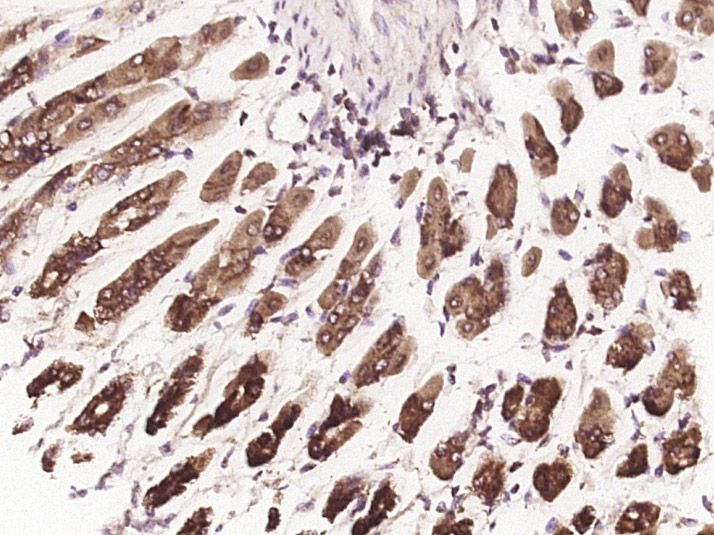
Rabbit Anti-phospho-Vinculin (Tyr822)antibody
Vinculin (phospho Y822); p-Vinculin (phospho Y822); CMD1W; CMH15; Epididymis luminal protein 114; HEL114; Metavinculin; MV; MVCL; OTTHUMP00000019861; OTTHUMP00000019862; VCL; VINC; VINC_HUMAN; Vinculin.
View History [Clear]
Details
Product Name phospho-Vinculin (Tyr822) Chinese Name 磷酸化粘着斑蛋白抗体 Alias Vinculin (phospho Y822); p-Vinculin (phospho Y822); CMD1W; CMH15; Epididymis luminal protein 114; HEL114; Metavinculin; MV; MVCL; OTTHUMP00000019861; OTTHUMP00000019862; VCL; VINC; VINC_HUMAN; Vinculin. Product Type Phosphorylated anti Research Area Cardiovascular Cell biology Signal transduction Cytoskeleton Immunogen Species Rabbit Clonality Polyclonal React Species Mouse, (predicted: Human, Rat, Chicken, Dog, Pig, Cow, Horse, Rabbit, Sheep, ) Applications ELISA=1:5000-10000 IHC-P=1:100-500 IHC-F=1:100-500 ICC=1:100-500 IF=1:100-500 (Paraffin sections need antigen repair)
not yet tested in other applications.
optimal dilutions/concentrations should be determined by the end user.Theoretical molecular weight 124kDa Cellular localization cytoplasmic Form Liquid Concentration 1mg/ml immunogen KLH conjugated synthesised phosphopeptide derived from human Vinculin around the phosphorylation site of Tyr822: SG(p-Y)RI Lsotype IgG Purification affinity purified by Protein A Buffer Solution 0.01M TBS(pH7.4) with 1% BSA, 0.03% Proclin300 and 50% Glycerol. Storage Shipped at 4℃. Store at -20 °C for one year. Avoid repeated freeze/thaw cycles. Attention This product as supplied is intended for research use only, not for use in human, therapeutic or diagnostic applications. PubMed PubMed Product Detail Vinculin is a cytoskeletal protein associated with cell-cell and cell-matrix junctions, where it is thought to function as one of several interacting proteins involved in anchoring F-actin to the membrane. Defects in VCL are the cause of cardiomyopathy dilated type 1W. Dilated cardiomyopathy is a disorder characterized by ventricular dilation and impaired systolic function, resulting in congestive heart failure and arrhythmia. Multiple alternatively spliced transcript variants have been found for this gene, but the biological validity of some variants has not been determined. [provided by RefSeq, Jul 2008]
Function:
Actin filament (F-actin)-binding protein involved in cell-matrix adhesion and cell-cell adhesion. Regulates cell-surface E-cadherin expression and potentiates mechanosensing by the E-cadherin complex. May also play important roles in cell morphology and locomotion.
Subcellular Location:
Cytoplasm > cytoskeleton. Cell junction > adherens junction. Cell membrane. Cytoplasmic face of adhesion plaques. Recruitment to cell-cell junctions occurs in a myosin II-dependent manner. Interaction with CTNNB1 is necessary for its localization to the cell-cell junctions.
Tissue Specificity:
Metavinculin is muscle-specific.
Post-translational modifications:
Phosphorylated; on serines, threonines and tyrosines. Phosphorylation on Tyr-1133 in activated platelets affects head-tail interactions and cell spreading but has no effect on actin binding nor on localization to focal adhesion plaques.
Aceylated; mainly by myristic acid but also small amount of palmitic acid.
DISEASE:
Defects in VCL are the cause of cardiomyopathy dilated type 1W (CMD1W) [MIM:611407]. Dilated cardiomyopathy is a disorder characterized by ventricular dilation and impaired systolic function, resulting in congestive heart failure and arrhythmia. Patients are at risk of premature death.
Defects in VCL are the cause of cardiomyopathy familial hypertrophic type 15 (CMH15) [MIM:613255]. It is a hereditary heart disorder characterized by ventricular hypertrophy, which is usually asymmetric and often involves the interventricular septum. The symptoms include dyspnea, syncope, collapse, palpitations, and chest pain. They can be readily provoked by exercise. The disorder has inter- and intrafamilial variability ranging from benign to malignant forms with high risk of cardiac failure and sudden cardiac death.
Similarity:
Belongs to the vinculin/alpha-catenin family.
SWISS:
P18206
Gene ID:
7414
Database links:Entrez Gene: 396422 Chicken
Entrez Gene: 7414 Human
Entrez Gene: 22330 Mouse
Omim: 193065 Human
SwissProt: P12003 Chicken
SwissProt: P18206 Human
SwissProt: Q64727 Mouse
Unigene: 643896 Human
Unigene: 279361 Mouse
Unigene: 164613 Rat
Product Picture
Bought notes(bought amounts latest0)
No one bought this product
User Comment(Total0User Comment Num)
- No comment



 +86 571 56623320
+86 571 56623320
 +86 18668110335
+86 18668110335

